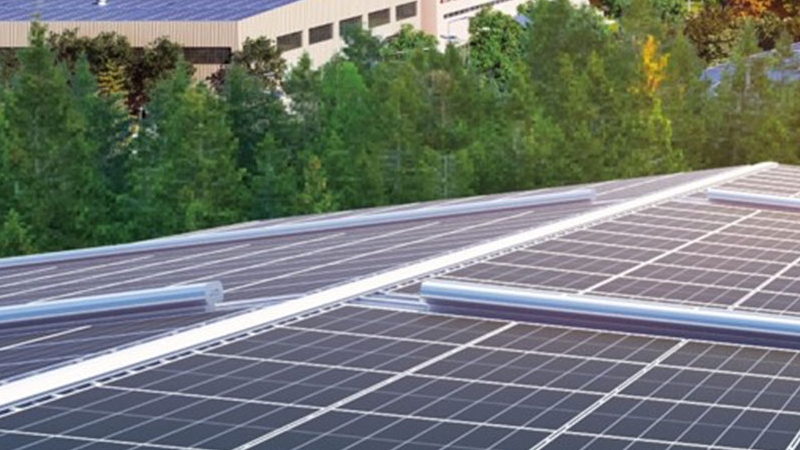分布式光伏發電帶來的作用
分布式光伏發電是一種新型的發電方式,它利用光伏組件將太陽能直接轉換為電能,具有清潔高效、分散布局、就近利用的特點。這種發電方式遵循因地制宜、清潔高效、分散布局、就近利用的原則,充分利用當地太陽能資源,替代和減少化石能源消費。分布式光伏發電系統通常安裝在用戶附近的低電壓等級電網中,如城市建筑物屋頂,必須接入公共電網,與公共電網一起為附近的用戶供電。
Distributed photovoltaic power generation is a new type of power generation method that uses photovoltaic modules to directly convert solar energy into electrical energy. It has the characteristics of clean and efficient, decentralized layout, and nearby utilization. This power generation method follows the principles of adapting to local conditions, clean and efficient, decentralized layout, and nearby utilization, fully utilizing local solar energy resources to replace and reduce fossil energy consumption. Distributed photovoltaic power generation systems are usually installed in low-voltage power grids near users, such as on the roofs of urban buildings, and must be connected to the public power grid to supply power to nearby users together with the public power grid.
分布式光伏發電與集中式光伏發電的主要區別在于其規模和運行方式。 集中式光伏發電通常指的是大型光伏電站,規模較大,電力通過升壓及長途運輸送到電網,再由電網分配給用戶。而分布式光伏發電則更注重就近發電、就近并網、就近轉換、就近使用的原則,有效提高了發電效率,減少了電力在升壓及長途運輸中的損耗。

The main difference between distributed photovoltaic power generation and centralized photovoltaic power generation lies in their scale and operation mode. Centralized photovoltaic power generation usually refers to large-scale photovoltaic power plants, where electricity is boosted and transported over long distances to the grid, and then distributed to users by the grid. Distributed photovoltaic power generation places more emphasis on the principles of nearby power generation, nearby grid connection, nearby conversion, and nearby use, effectively improving power generation efficiency and reducing power losses during boosting and long-distance transportation.
國家對分布式光伏發電的支持政策也體現了對其重要性的認可。例如,國家大力推廣分布式光伏發電項目,以促進清潔能源的使用,減少對化石燃料的依賴,從而實現減排目標。此外,國家還通過提供補貼、優惠貸款等方式鼓勵企業和個人安裝分布式光伏發電系統。
The national support policies for distributed photovoltaic power generation also reflect recognition of its importance. For example, the country vigorously promotes distributed photovoltaic power generation projects to promote the use of clean energy, reduce dependence on fossil fuels, and achieve emission reduction goals. In addition, the government encourages enterprises and individuals to install distributed photovoltaic power generation systems through subsidies, preferential loans, and other means.
安裝分布式光伏發電系統需要的手續一般包括向當地電力部門提交申請、獲得必要的許可和證書、以及與電力公司協商并網事宜。具體的流程和要求可能會根據地方政策和規定有所不同,因此建議在進行安裝前詳細咨詢當地電力部門或專業機構以獲取準確的信息和指導。
The procedures required for installing a distributed photovoltaic power generation system generally include submitting an application to the local power department, obtaining necessary permits and certificates, and negotiating grid connection matters with the power company. The specific process and requirements may vary depending on local policies and regulations, so it is recommended to consult the local power department or professional institutions in detail before installation to obtain accurate information and guidance.
總的來說,分布式光伏發電是一種具有廣闊發展前景的能源利用方式,它不僅能夠減少環境污染,還能夠提高能源利用效率,是實現可持續發展的重要手段之一
Overall, distributed photovoltaic power generation is an energy utilization method with broad development prospects. It can not only reduce environmental pollution, but also improve energy utilization efficiency, and is one of the important means to achieve sustainable development
新聞推薦
product recommendation聯系方式
Contact Information

 TEL:0531-82390078
TEL:0531-82390078 TEL:18805312017
TEL:18805312017 MAI:sdzdny001@163.com
MAI:sdzdny001@163.com 公司地址: 濟南市歷下區山大路157號
公司地址: 濟南市歷下區山大路157號 天合藍天·山東種電
天合藍天·山東種電 備案號:魯ICP備17052940號-2
魯公網安備37010202700164號
備案號:魯ICP備17052940號-2
魯公網安備37010202700164號
 網站地圖|XML|TXT
網站地圖|XML|TXT

掃一掃方便咨詢我們

截屏,微信識別二維碼
微信號:18805312017